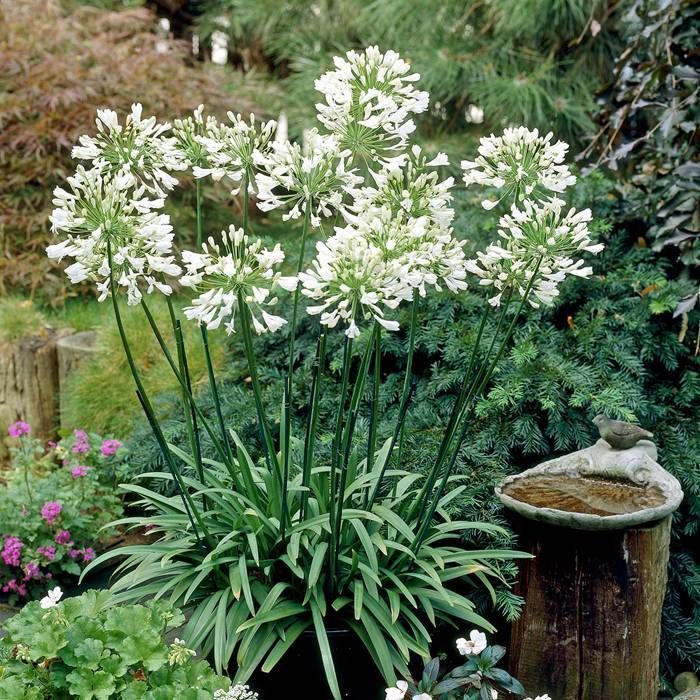Common Agapanthus Problems and Exactly How to Address Them
Common Agapanthus Problems and Exactly How to Address Them
Blog Article
Releasing the Secret to Successful Agapanthus Growing: Tips and Techniques for a Flourishing Garden
In the world of gardening, growing agapanthus efficiently calls for a critical strategy that includes various elements of plant care. By comprehending the subtleties of agapanthus farming, one can develop an environment where these plants thrive and bloom perfectly.
Growing Agapanthus: Ideal Practices
When growing Agapanthus, appropriate soil preparation is crucial for making sure successful growth and advancement of these lovely flowers. Agapanthus, frequently called Lily of the Nile or African lily, thrives in well-draining dirt with a somewhat acidic to neutral pH level - Agapanthus. Prior to planting, it is essential to modify heavy clay soils with raw material such as compost or peat moss to enhance drain and supply vital nutrients for the plants
To grow Agapanthus, choose an area that obtains complete sunshine to partial shade, as this will certainly promote healthy development and plentiful blooming. Dig a hole twice the diameter of the plant's origin round and position the Agapanthus at the very same deepness it was previously expanding. Carefully backfill the opening with dirt, pushing down firmly to remove any type of air pockets around the origins.
Water the recently planted Agapanthus extensively and remain to maintain the dirt evenly wet, particularly throughout the plant's active expanding season. Agapanthus. Applying a well balanced fertilizer once a month can additionally sustain the plant's growth and blooming. By adhering to these finest practices for growing Agapanthus, you can produce a stunning display of these exciting flowers in your garden
Ideal Soil Conditions for Agapanthus
For optimal growth and flowering success of Agapanthus plants, making certain the dirt problems are ideal is crucial. Agapanthus favors soil that is rich in nutrients, so including a balanced fertilizer during the expanding period can promote healthy growth and lively flowers.

Watering and Fertilizing Tips
To ensure healthy growth and vibrant flowers, correct watering and feeding methods are important for successful Agapanthus growing. Agapanthus plants benefit from normal watering, specifically throughout the expanding period.
When it concerns fertilizing Agapanthus, a well balanced fertilizer with equal components nitrogen, phosphorus, and potassium can be applied in the spring to advertise healthy and balanced development and blooming. Slow-release plant foods are optimal for providing nutrients look at this website slowly over an extended duration. Stay clear of over-fertilizing, as this can bring about too much foliage growth at the cost of blossoms.
In addition, integrating raw material like garden compost right into the soil can enhance nutrient levels and improve dirt framework, assisting in the general health of the Agapanthus plants. By adhering to these watering and fertilizing pointers, gardeners can guarantee their Agapanthus plants flourish and generate sensational display screens of blossoms.
Pruning and Deadheading Methods
Appropriate pruning and deadheading techniques play a vital role in preserving the health and aesthetics of Agapanthus plants, enhancing the necessary methods of watering and fertilizing for successful growing. Pruning Agapanthus includes getting rid of invested flower heads, dead or yellowing leaves, and general shaping of the plant to promote far better growth. Deadheading, the process of getting rid of faded flowers, not just boosts the plant's appearance however additionally encourages more growing.
When deadheading Agapanthus, it is advisable to clip off the blossom stem at the base making use of sharp, clean shears. This process reroutes the plant's power from seed manufacturing back right into root and foliage growth, advertising a much healthier and more robust plant. Routine deadheading can expand the blooming period of Agapanthus and stop self-seeding, which can bring about congestion.
In terms of trimming, Agapanthus generally take advantage of a light trim after flowering to clean the plant and encourage fresh growth. Cutting back the spent blossom stems and eliminating any type of damaged or dead foliage helps maintain the plant's vigor and total look. Nonetheless, it is important to avoid cutting right into the crown of the plant, as this can damage its wellness.

Protecting Agapanthus From Pests and Diseases
Implementing efficient insect and condition administration techniques is important to protecting the health and vigor of Agapanthus plants in cultivation. Agapanthus are usually sturdy plants, but they can still come down with various parasites and illness if not effectively looked after. One common bug that image source affects Agapanthus is the Agapanthus borer, a caterpillar that passages into the plant, creating damage to the flowers and leaves. To protect against invasions, regular assessment of the plants is important. If borers are detected, they can be by hand removed, or insecticidal soap can be made use of as a control procedure.
In enhancement to parasites, Agapanthus are at risk to conditions such as origin rot and fungal fallen leave places. By remaining cautious and resolving parasite and illness problems quickly, garden enthusiasts can help their Agapanthus thrive and flourish.

Conclusion
To conclude, successful growing of agapanthus calls for appropriate growing techniques, suitable soil conditions, appropriate watering and fertilizing, regular trimming and Click Here deadheading, and protection from insects and conditions. By adhering to these tips and methods, garden enthusiasts can guarantee a growing garden filled with attractive agapanthus blooms. Agapanthus. Keep in mind to keep constant treatment and focus to information to advertise the health and durability of these sensational plants
When growing Agapanthus, correct soil preparation is necessary for making certain successful growth and development of these stunning flowers.Water the recently grown Agapanthus completely and proceed to maintain the dirt equally wet, specifically throughout the plant's energetic expanding period.For optimum development and growing success of Agapanthus plants, making certain the dirt problems are ideal is essential. When planting or transplanting Agapanthus, ensure the dirt is well-prepared to offer the necessary foundation for the plants to establish themselves successfully. One common pest that affects Agapanthus is the Agapanthus borer, a caterpillar that passages right into the plant, triggering damage to the blossoms and leaves.
Report this page